The winner - Mailchimp
Life-changing superhero
In this comparison, Mailchimp wins six out of eleven rounds. Two rounds end in a tie, and there are only three aspects where Brevo outperforms Mailchimp. Continue reading to learn about the cases where Mailchimp has the edge over Brevo and why.
What Mailchimp features are better than Brevo?
- Capabilities for building email campaigns, support for more email types, templates, and A/B testing elements
- Landing page builder, contact migration and form analytics
- Segmentation capabilities suited for ecommerce businesses
- Integration for almost all your favourite ecommerce tools
- A/B test can only test the subject line or content
- Features such as form analytics, and seamless form integration into the website are lacking
- Segmentation based on attributes related to ecommerce is unavailable
- Although similar in generosity, it offers fewer integrations
Mailchimp and Brevo (formerly Sendinblue) are among the finest email marketing tools in the market.
In the Shopify App Store, Mailchimp has a 3.4 rating while Brevo has a rating of 4.2. But that’s probably not enough information to make a buying decision, is it?
You need to know if the tool has features tailored for ecommerce. It’s also important to know if it can boost your conversions without costing a lot, leading to a higher ROI.
To help you make the right decision, we’ve put together this Mailchimp vs. Brevo guide.
Mailchimp vs Brevo: quick overview
Brevo and Mailchimp are both popular tools with practical features for ecommerce stores. Each tool has areas where it shines and others where it’s lacking.
We’ll do an in-depth comparison of the marketing features that Brevo and Mailchimp offer. We’ll compare their pricing, integrations, customer support, and ease of getting started.
Here’s a quick summary.
Mailchimp vs. Brevo comparison: feature by feature
Let’s get a little deeper in the comparison.
Ease of getting started
A marketing software that has a short learning curve and fewer complications makes it much easier to get the hang of it.
Mailchimp
Mailchimp has an easy signup process.
You’ll need to provide your credit card details to access the 30-day trial for the Standard and Essentials plans. However, you don’t need to provide your credit card details for the free plan.
Details required during signup include:
- Email address and username
- Account name
- Business name
- Phone number
- Business physical address
- Website URL
- Number of contacts
- What you expect to achieve with Mailchimp
For a first-time user, Mailchimp is fairly easy to use. It has a clear design and intuitive navigation.
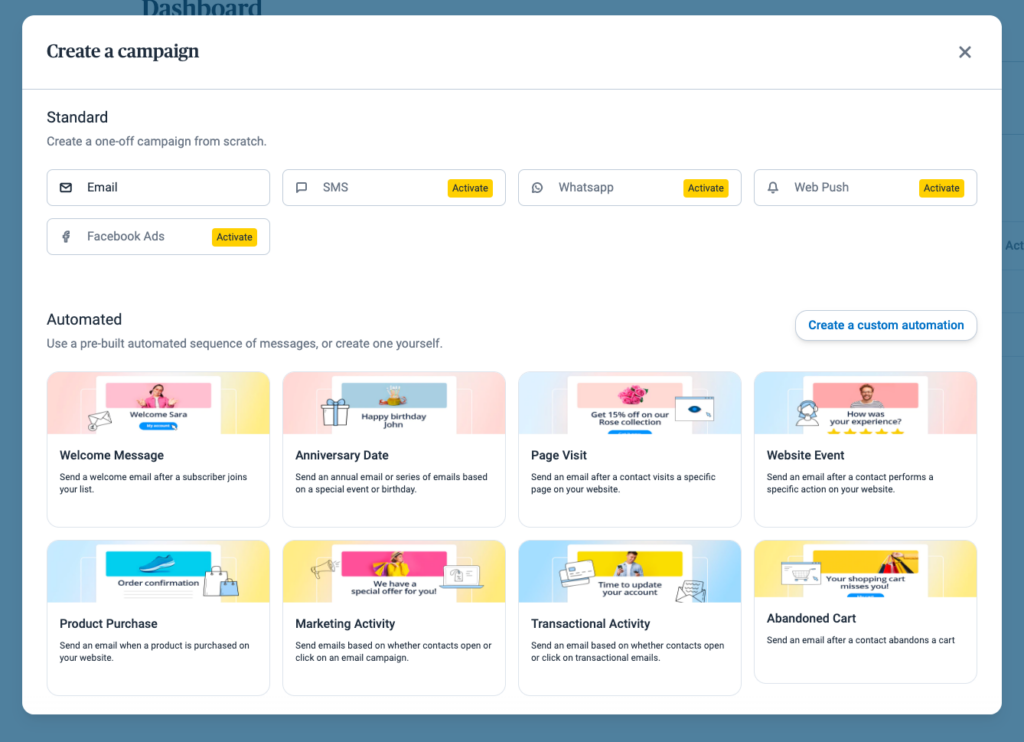
The best part is that you get a checklist that helps you set up your account properly. It’s a helpful feature for ecommerce business owners dipping their hands in email marketing for the first time.
A downside here is that Mailchimp has a lot of functionality, which makes it hard to find the features you need. For instance, we had a hard time finding where to change a sender’s email.
Brevo
Brevo’s signup process is easy as well.
You don’t need to provide your credit card details to get started with Brevo’s free plan. Once you choose to upgrade, you’ll have to provide those details.
For signup, you’ll need to provide details like:
- Name
- Business name and website address
- Email address
- Physical address
- Number of people on your team
- Number of contacts
You’ll also need to verify your phone number.
Brevo has a beginner-friendly user interface.
You may find it a little different than other email marketing automation software. But you’ll find everything you need with ease. For instance, unlike Mailchimp, we could easily find where to change the sender’s email address.
However, a little more guidance for people with no prior experience with marketing automation software would be good.
Whether you use Brevo or Mailchimp, you get an intuitive user interface.
It’s easy to find features in Brevo, but it’s a struggle with Mailchimp. But Brevo fails to provide proper guidance to beginners, an area where Mailchimp shines.
Building an email campaign
With both builders, it’s easy to add your campaign details and get it running.
Mailchimp gives you a user-friendly email builder powered with AI tools.
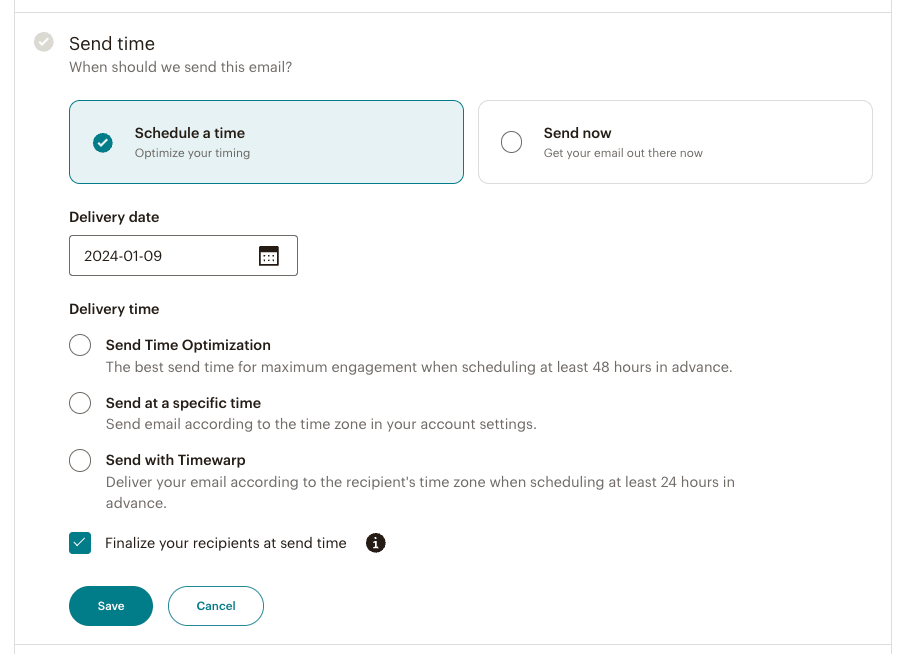
Using Brevo to build an email campaign is easy. The inbox preview tool, in particular, is helpful.

Neither Mailchimp or Brevo goes the extra mile to provide out-of-the-box features to help ecommerce business owners with their email campaigns, like Omnisend has done with its Product Picker.
Generating unique coupon codes, for instance, is only possible through integrations like Coupon Carrier.
Let’s look at the features each offers for building email campaigns:
Easy to name your campaigns, add preheaders, change the colors and texts of your emails, etc.
Not as smooth as on Mailchimp
A searchable library of GIFs; integration with Adobe Photoshop, Canva, and Unsplash, which gives you a selection of stock images; uploading images from your Instagram account
A rich and searchable library of over 200 royalty-free images; built-in image editing tools
Over 100 modern templates. But templates in the free plan are only six and quite basic.
42 templates available. Some are modern, some are outdated, and limited occasion-ready templates
A feature known as Dynamic Content enables personalization.
The Brevo Template Language enables personalization. By inserting placeholders in your email templates, you can personalize your emails using contact-specific data.
- Regular
- Plain-text
- A/B testing
- Automated
- Regular
- A/B testing
- Automated
Mailchimp
Mailchimp has some unique capabilities like sending postcards, creating surveys, and getting recommendations for your subject lines.
It also gives you 25 inbox preview tokens courtesy of Litmus. But that’s only available on the paid plans.
In addition, you can only schedule email campaigns under the paid plans.
Brevo
Nothing much stands out about Brevo’s email campaign features.
However, the email editor isn’t already populated with your branding data, like colors and logo when you open it. You have to import your brand elements into the editor, and this feature isn’t easy to find.
What’s more, the A/B test can only test the subject line or content. Mailchimp allows you to test the subject line, content, send time, and ‘From’ name.
Mailchimp wins this round. It offers better capabilities for building email campaigns. It supports more email types, has more templates, and you can test more elements with A/B testing.
Marketing automation
Automation helps you save time spent on repetitive tasks. You can focus on other areas like creating strong ecommerce marketing strategies and analyzing your campaign results.
Let’s do a Mailchimp vs. Brevo comparison in this area.
Mailchimp
The user-friendliness of Mailchimp’s automation is similar to other top email automation software like Omnisend and Klaviyo.
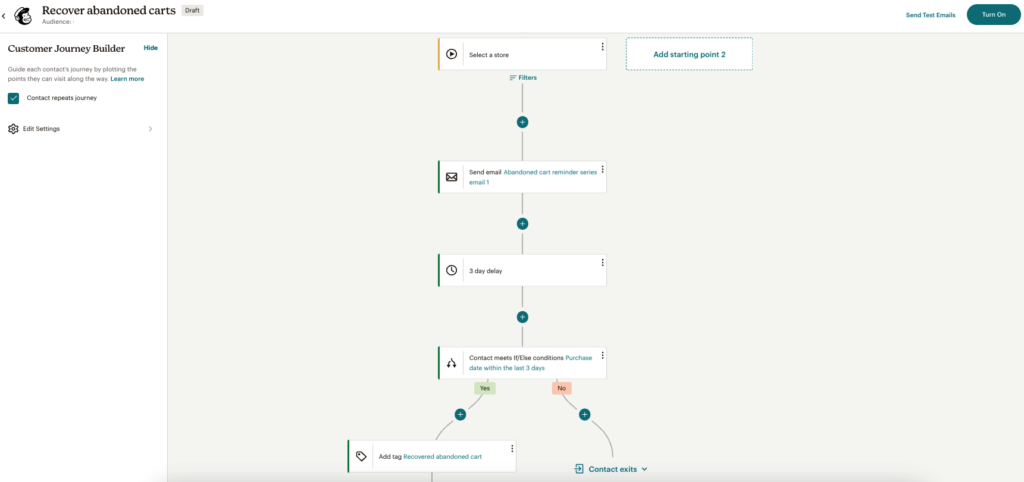
You get over 70 pre-built journey templates. The templates include different social media channels (additional integrations might be required) and a ready workflow structure. Adding the content is up to you.
Standard and Premium plan customers get multiple starting and branching point capabilities.
An area Mailchimp fails in is the inability to add web push notifications or built-in text messages in automation. For this functionality, you will need extra integration, for example with Twilio.
Brevo
Marketing automation using Brevo is logical. Plenty of pre-built journey templates are available, but not as many as Mailchimp.
Like Mailchimp, you only get a ready workflow, but adding content is up to you. Plus, Brevo doesn’t pre-fill the company logo and branding assets.
But unlike Mailchimp, Brevo lets you add SMS, WhatsApp, and web push notifications into the workflow, which is a great addition.
You can also add splits and conditions to the automation.
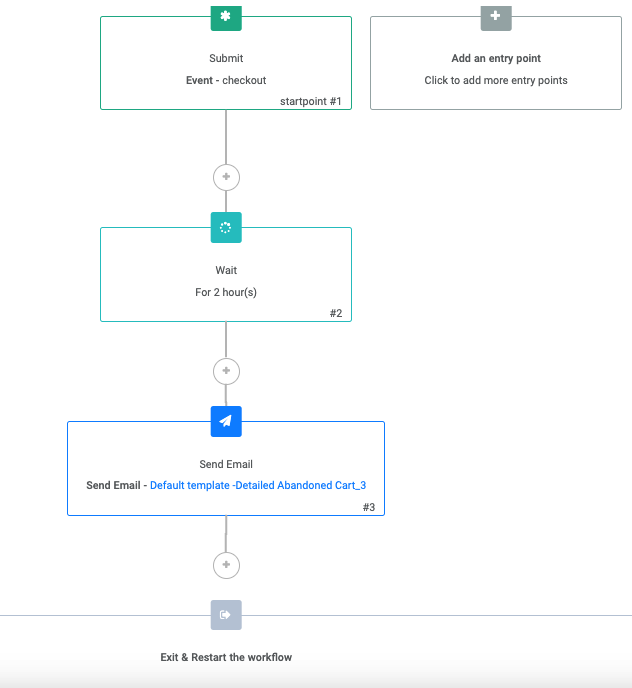
Brevo also provides a transactional email offering with a pre-built automation template for it, which is very helpful for beginners.
That said, a downside to Brevo is that the automation capabilities are a step behind when compared to other email marketing tools.
Brevo wins. Its support for multiple channels like SMS, WhatsApp, and web notifications helps ecommerce store owners adopt an omnichannel marketing approach.
Signup forms and landing pages
Signup forms and landing pages are powerful lead generation tools.
A well-designed signup form strategy helps you build your audience and boost your conversions.
Mailchimp
Mailchimp doesn’t offer ready-to-use signup forms. But it’s pretty easy to design modern signup forms using your brand’s colors.
You can also measure the performance of your forms. However, only basic analytics are available, such as the number of subscribers generated.
For landing pages, you get nine easily customizable templates and a powerful landing page builder.
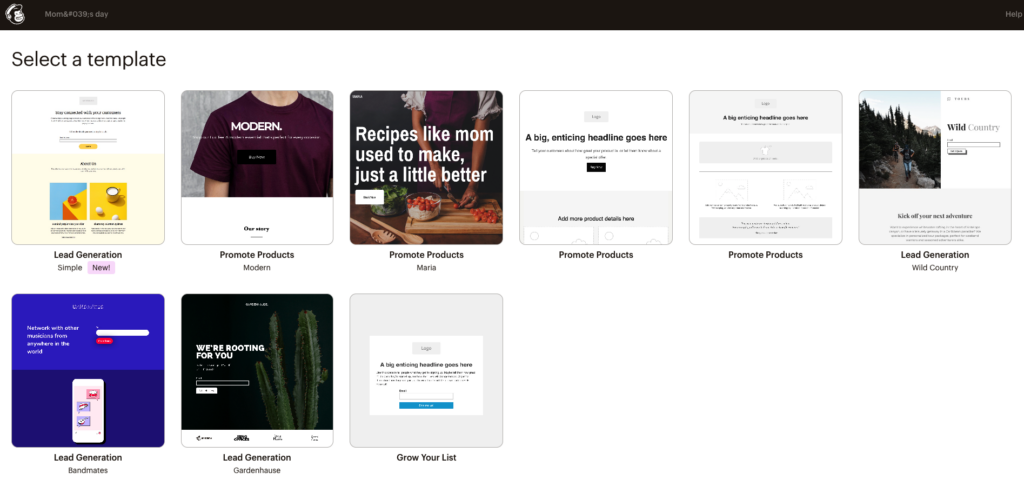
Managing the list of subscribers is fairly easy on Mailchimp. You can tag and segment your lists with ease.
It’s important to note that, unlike other marketing tools, you’ll still pay for repetitive contacts in your database. This can cause unnecessary expenses and extra work to ensure there aren’t any duplicates on your lists.
Another weakness with Mailchimp is that you can only have one hosted popup for an audience.
Brevo
Brevo’s forms look very similar to Mailchimp’s. No ready-made templates offered. When you open the form builder, you’ll find one editable form suggestion and a flexible builder to edit it according to your brand.
The form performance analytics that you can see in Brevo is the number of signups through that particular form.
Although signup forms are available for all Brevo customers, the landing page builder is only available for the Business and Enterprise plan.
Contact management in Brevo is rather basic. For instance, you can’t add tags. What’s unique, however, is:
- Brevo’s scoring system for contacts. It facilitates personalization and segmentation.
- The multi-list subscription feature. You can ask customers about their interests and preferences during signup. The form then automatically adds the contact to the corresponding contact list.
- You can add CAPTCHA to your forms. But the setup is a little complicated
- You can block contacts
A major flaw with Brevo is its inability to automatically launch your popup forms on your website. You have to manually copy and paste your HTML or iframe snippet into the website code to integrate them.
In addition, contact migration from other tools is lacking. This is a vital feature provided by other email marketing tools.
Mailchimp’s landing page builder is one of the best you can find. It’s comprehensive and suitable for an ecommerce store. Brevo’s landing page builder seems a bit more complicated.
The form builders look like a tie. Both don’t have ready-made templates and you have to customize them on your own.
Although Brevo provides a few unique features to help ecommerce businesses, it also lacks a lot of important features, such as contact migration, form analytics, and a seamless form launch into the website. In this regard, Mailchimp wins.
Segmentation
Email list segmentation enables you to send personalized messages, which increases the likelihood of conversions.
Mailchimp
Mailchimp offers a powerful segmentation tool which includes three basic ready-to-go segments. When creating a new segment, you can include up to 5 conditions in each segment. While this may be enough for most ecommerce businesses, knowing you can add more when the need arises would be good.
Mailchimp also offers predictive segmentation, which puts customers into segments based on their likelihood to buy. However, this feature is part of its advanced segmentation and is available only for Premium plan users.
Brevo
Brevo’s segmentation features are a bit basic for ecommerce when compared to other tools like Klaviyo and Omnisend. There are only a few ready segments: most engaged subscribers, inactive email subscribers, all email subscribers and contacts from a country code.
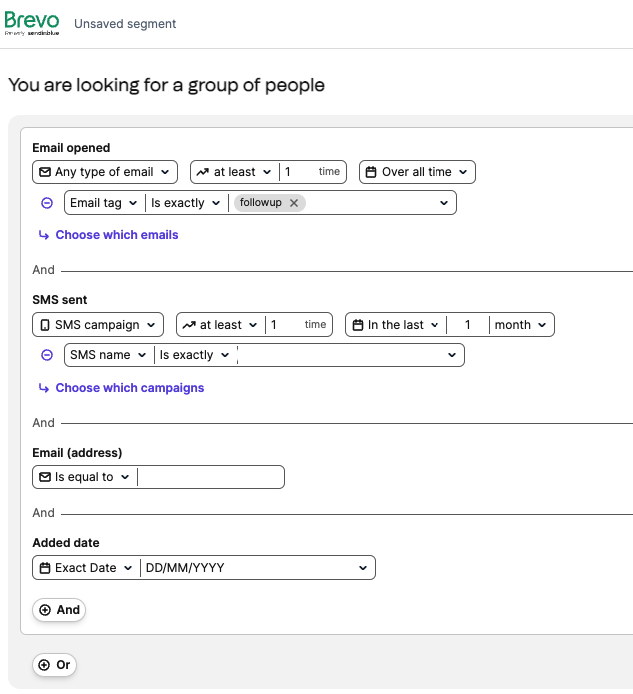
That said, all plans get advanced segmentation, including the free one. You can sort subscribers based on source, email activity, and attributes like location.
A downside is that you can’t segment your contacts based on attributes related to ecommerce, such as shopping behavior and website activity.
Mailchimp’s segmentation capabilities are more suited for ecommerce businesses.
Analytics
Good analytics can help you make or break your business. Comprehensive insights on customer behavior, email engagement, and revenue sources are all crucial for online stores. But other websites probably won’t miss them at all. So what can you expect from these two platforms?
Mailchimp
Mailchimp analytics are wide. You get metrics, such as:
- Conversions
- Standard opens, clicks, and unsubscribe rates
- Social media engagement
- Landing page engagement
- Email forwards and opens
You get real-time statistics on your campaigns — all in a centralized location.
Additionally, you can get shareable comparative reports for regular and RSS campaigns you’ve sent in the last 18 months. This can help you identify patterns with your engagements.
However, the advanced reporting is only available to Premium plan customers.
Although Mailchimp provides a variety of analytics, tools like Klaviyo outperform it with some ecommerce insights.
Brevo
Brevo’s analytics provides geolocation data and device statistics. You get open and click activity reports, as well as a heat map. But these are only available in the Business and Enterprise plans.
Conversion reports are also available to see the ROI of your email marketing campaigns.
Mailchimp’s analytics will be enough for the vast majority of ecommerce businesses. However, they are only available on the highest tier plan. Lower tier plans offer quite limited reporting.
It’s a similar situation with Brevo. On the lower tier plans you’ll get very basic email engagement reports, and the ecommerce insights are available only on the higher tier plans.
Overall, Mailchimp offers better reporting if you are ready to pay for it.
Customer support
Support needs to be available when you get stuck or need guidance with the features.
Mailchimp
For Mailchimp’s free plan, customer support is only available through email for the first 30 days. Paid plans come with:
- 24/7 email and live chat support
- Onboarding support with dedicated onboarding offered in the Premium plan
- Marketing advice from experts
Premium plan members get phone support as well.
The quality of support isn’t bad. We got a response from the live chat support in about 2-3 minutes.
There are loads of useful resources and guides on the website too. This includes a library with articles categorized by marketing channel, business stage, etc.
There’s also Mailchimp 101, which is a tutorial for Mailchimp beginners. For those who prefer videos, there are plenty of YouTube videos available in a variety of languages.
Brevo
With Brevo, everyone gets unlimited email support.
24/7 phone and live chat support are only available in the higher-priced plans though. Enterprise plan customers also get a dedicated account manager.
Like Mailchimp, there are YouTube tutorials and a help center with articles categorized by topic.
There’s also a free email marketing course—Brevo Academy, which includes a certification.
Mailchimp offers more support to ecommerce business owners, such as marketing advice and onboarding support. However, Free plan users are left on their own.
Integrations
Integrations make it possible for the email marketing tool to work with your other existing software without restrictions.
Mailchimp
Mailchimp integrates with over 300 tools of a wide variety.
From customer service to developer tools, analytics, payments, and point-of-sale tools, you can integrate almost all your favorite ecommerce tools.
Brevo
Brevo has over 150 integrations, half that of Mailchimp’s. However, they cover a wide range of functionalities and have some integrations with connectors like Zapier.
Categories covered include payment services, helpdesk, contact management, CMS, and CRMs, among others.
Both tools are generous with integrations, but Mailchimp offers more than Brevo.
Compatibility with other marketing channels
An email marketing tool that helps you connect with your customers through other channels is great. It enables you to boost customer engagement and expand your reach.
Mailchimp
Mailchimp connects with many marketing channels including:
- SMS
- Facebook ads
- Instagram ads
- Google ads
It lacks compatibility with push notifications (both web and mobile). You can get those channels via integrations with other tools.
Brevo
Brevo connects with:
- SMS
- Push notifications
- Facebook ads – available for Business and Enterprise plan customers
You can also connect with your customers through Brevo Conversations. This is a live chat via WhatsApp, Facebook Messenger, Instagram, and a chat widget.
Brevo takes this one. It supports more marketing channels than Mailchimp does.
Generative AI tools
Regarding AI features, Mailchimp has more of them to offer. Recently, it has launched Intuit Assist which can help you personalize and create content and subject lines, optimize your marketing strategy, and more.
Meanwhile, Brevo, offers email content generator only.
Mailchimp has more robust AI tools.
Price comparison
When choosing a plan, pay more attention to the features offered on each plan. Not just the price.
The most basic plans often lack the features necessary to effectively market your ecommerce store.
Mailchimp has four plans:
- Free
- Essentials: Starts at $13/month
- Standard: Starts at $20/month
- Premium: Starts at $350/month
The free and Essentials plans lack features like pre-built customer journeys, dynamic content, and send time optimization.
Brevo has four plans:
- Free
- Starter: Starts at $25/month
- Business: Starts at $65/month
- Brevo+: Custom
The free and Starter plans lack features like a landing page builder and A/B testing.
Summary: which one wins?
4.5
4.1
500 subscribers – $13
1000 subscribers – $27
5000 subscribers – $75
10,000 subscribers – $110
50,000 subscribers – $385
100,000 subscribers – $800
Number of subscribers is unlimited.
20K emails – $19
40K emails – $29
60K emails – $39
100K emails – $59
- Free trial is for 30 days, you can test out the majority of paid features
- 1000 email sends/m
- A few basic email template
- 30 days email support
- Up to 300 emails/day
- Email template
- Basic email reports
- Transactional emails
- SMS and WhatsApp campaign
- Email support
- The tool has a very wide range of features
- Mailchimp has a lot of integrations
- The tool is user friendly
- Good free plan
- Great marketing channels compatibility
- Good marketing automation features
- Transactional emails
- Mailchimp charges for email duplicates
- Very limited free plan, and paid plans get expensive quickly
- Email templates available on Free plan are too basic for current ecommerce needs
- Very basic signup forms
- Quite basic reporting
- Many features don’t work out of the box, requires extra setup.
Solopreneurs, startups, bloggers, non-profit organizations
Non-profit organizations, ecommerce beginners, B2B companies
Ecommerce stores that are in their active growth stage
Ecommerce stores that are in their active growth stage
If you are in the early stages of starting your ecommerce business, you can use Brevo or Mailchimp. However, if you are a more established business, we recommend choosing Mailchimp. It offers more advanced features that cater to your specific needs.
If you’re looking for a solution for a blog or non-profit organization, Brevo is cheaper while providing enough features to support your needs.
Read full reviews
Related picks for you
Our team strives to be accurate and unbiased in reviewing email tools. However, we recognize that mistakes can happen, and it’s essential for us to stay up to date. If you come across any errors or things that need to be reviewed again, please let us know.





Leave a Reply